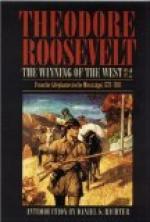So rapid were the movements of the Americans, and so unexpected the attack, that a loyalist officer, who had been out reconnoitring, had just brought word to the British commander that there was no sign of danger, when the first shots were heard; and by the time the officer had paraded and posted his men, the assault had begun, his horse had been killed, and he himself wounded. [Footnote: “Essays in Military Biography,” Col. Charles Cornwallis Chesney, London, 1874. On p. 323 begins a memoir of “A Carolina Loyalist in the Revolutionary War.” It is written by the loyalist himself, who was presumably a relation of Col. Chesney’s. It was evidently written after the event, and there are some lapses. Thus he makes the war with the Cherokees take place in 1777, instead of ’76. His explanation of Tarleton’s defeat at the Cowpens must be accepted with much reserve. At King’s Mountain he says the Americans had fifteen hundred men, instead of twenty-five hundred, of which Allaire speaks. Allaire probably consciously exaggerated the number.]
When Ferguson learned that his foes were on him, he sprang on his horse, his drums beat to arms, and he instantly made ready for the fight. Though surprised by the unexpected approach of the American, he exerted himself with such energy that his troops were in battle array when the attack began. The outcrops of slaty rock on the hill-sides made ledges which, together with the boulders strewn on top, served as breastworks for the less disciplined tories; while he in person led his regulars and such of the loyalist companies as were furnished with the hunting-knife bayonets. He hoped to be able to repulse his enemies by himself taking the offensive, with a succession of bayonet charges; a form of attack in which his experience with Pulaski and Huger had given him great confidence.
At three o’clock in the afternoon the firing began, as the Americans drove in the British pickets. The brunt of the battle fell on the American centre, composed of Campbell’s and Shelby’s men, who sustained the whole fight for nearly ten minutes [Footnote: Campbell MSS. Letter of Col. Wm. Campbell, Oct. 10, 1780, says 10 minutes: the official report (Gates MSS.) says 5 minutes.] until the two wings had had time to get into place and surround the enemy. Campbell began the assault, riding on horseback along the line of his riflemen. He ordered them to raise the Indian war-whoop, which they did with a will, and made the woods ring. [Footnote: Richmond Enquirer (Nov. 12, 1822 and May 9, 1823) certificates of King’s Mountain survivors—of James Crow, May 6, 1813; David Beattie, May 4, 1813, etc., etc. All the different commanders claimed the honor of beginning the battle in after-life; the official report decides it in favor of Campbell and Shelby, the former being the first actually engaged, as is acknowledged by Shelby in his letter to Arthur Campbell on October 12, 1780.] They then rushed upwards and began to fire, each on his own account; while their war cries echoed along the hill-side. Ferguson’s men on the summit responded with heavy volley firing, and then charged, cheering lustily. The mountain was covered with smoke and flame, and seemed to thunder. [Footnote: Haywood, 71; doubtless he uses the language of one of the actors.]




